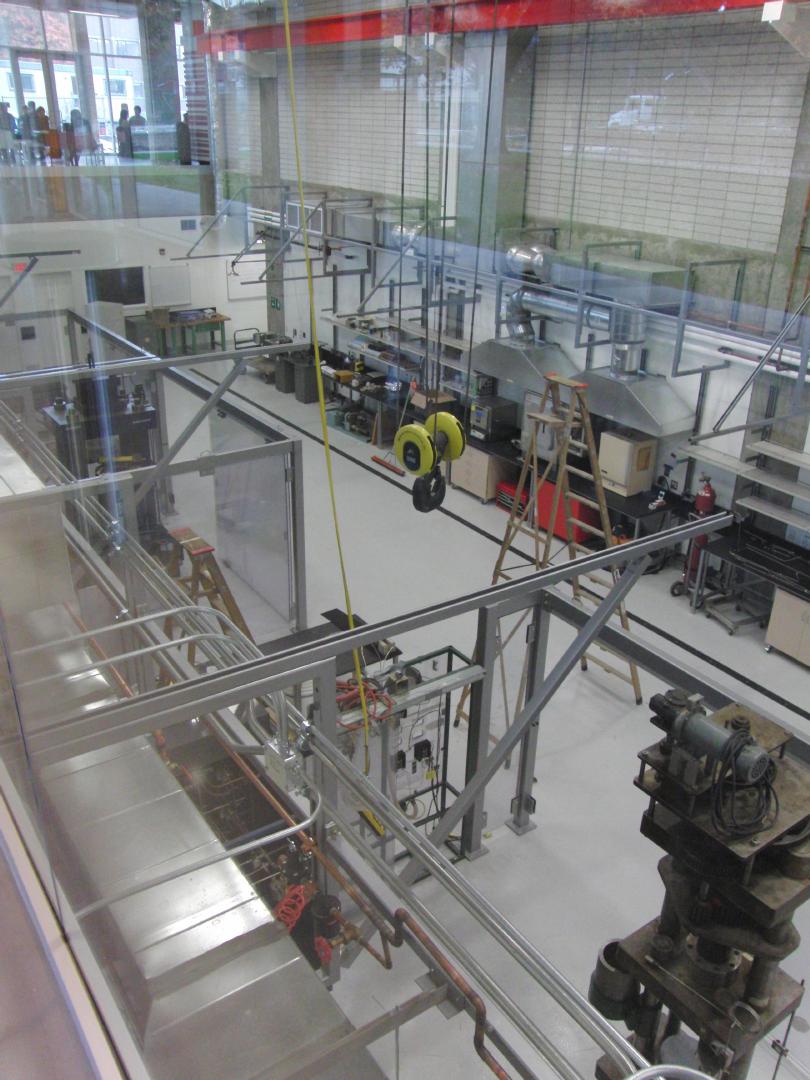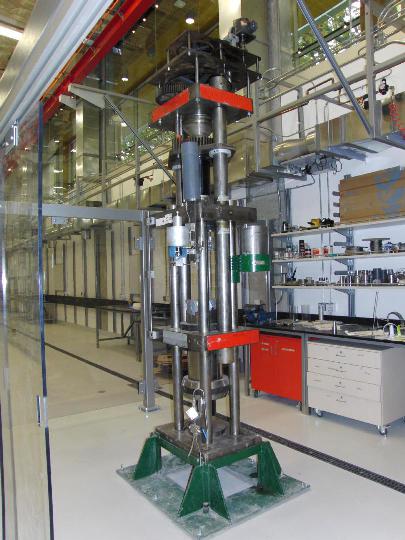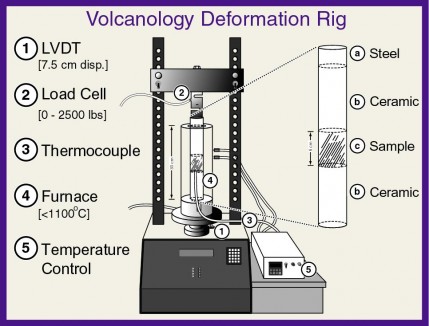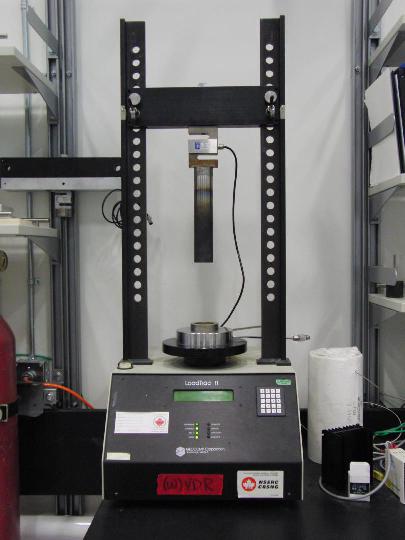Centre for Experimental Study of the Lithosphere
Overview
 The Centre for Experimental Study of the Lithosphere houses a collection of instruments that measure the physical properties of rocks in both static and dynamic states to provide rate laws, empirical relationships and define new mechanistic descriptions of the behaviour and evolution of Earth materials. This new facility contributes to a wide range of research programs investigating 1) physical properties and deformation of crustal and mantle materials, 2) fluid-rock interactions and transport phenomena, and 3) properties and physical chemistry of magmatic systems.
The Centre for Experimental Study of the Lithosphere houses a collection of instruments that measure the physical properties of rocks in both static and dynamic states to provide rate laws, empirical relationships and define new mechanistic descriptions of the behaviour and evolution of Earth materials. This new facility contributes to a wide range of research programs investigating 1) physical properties and deformation of crustal and mantle materials, 2) fluid-rock interactions and transport phenomena, and 3) properties and physical chemistry of magmatic systems.
Research
The experimental examination of mechanical and transport properties is one of the most active and dynamic research fields in the geosciences. Two of the major research areas are outlined below.
-
Physical properties of geomaterials
One of the most basic enterprises in the Earth Sciences is to understand the relation between the structure of a material and its properties. Many of the important questions currently being addressed in seismology, geodynamics, structural geology and petrology, for example, requires the input of hard, physical measurements of material properties.
A major new collaborative research project (Tosdal, Oldenburg, Russell, Dipple, Scoates) between the Geophysical Inversion Facility and the Mineral Deposits Research Unit in EOS requires measurement of magnetic susceptibility and density of rock samples from four major ore deposits. The physical property data form the bridge between the geologic data (field maps and drill programs) and the remote sensing of unexplored mineral deposits. These data are essential for inverting geophysical measurements into predictions of the geometry and distribution of ore deposits. To evaluate the potential of volcanic deposits to act as natural storage depots for hazardous material, their physical properties and how the properties change with changing physical conditions (such as P,T) must be known. The structural geometry of mantle lithosphere, which provides insight into mantle convection processes can only be deduced using seismology. To generate an accurate geophysical model of mantle geometry, the elastic properties of lithospheric lithologies (e.g. Vp/Vs) must be known.
-
Rheology of geomaterials
The rheological behaviour of geomaterials (i.e. the relationship between stress, strain and strain rate), ranging from the melt material (volcanic and intrusive) through to the lower mantle, controls the manner in which the Earth deforms. Quantification of the rheological behaviour of materials can only be accomplished through experimental deformation, which provides the data required to formulate an empirical constitutive flow law for the material of interest. Using these flow laws, we can predict the strength or the strain rate of various rock types, hence of various locations within the earth, under a range of physical conditions (e.g. P,T, Fluid composition). This information allows us to predict fundamentally important issues regarding Earth's behaviour, such as the strength of mantle convection, the timescales of compaction and welding in volcanic tuffs, and the potential strength of earthquakes.
Experimental Equipment
-
Rock Deformation Equipment
 The rock deformation equipment housed in CESL is diverse and innovative. For example, we can measure crack development and fluid flow in large samples (see table below) under brittle conditions or the generation of melts from materials under high temperatures. Rock deformation experiments are performed so that we can determine the mechanism and evolution of deformed rocks and to quantify their rheological behaviour.
The rock deformation equipment housed in CESL is diverse and innovative. For example, we can measure crack development and fluid flow in large samples (see table below) under brittle conditions or the generation of melts from materials under high temperatures. Rock deformation experiments are performed so that we can determine the mechanism and evolution of deformed rocks and to quantify their rheological behaviour.Measurements made: Rock strength (i.e. rheology) at a variety of physical conditions (i.e. temperature, confining pressure, pore fluid pressure, fluid chemistry). Obtain differential stress, strain and strain rate relationships as a function of extrinsic parameters.
Temp (°C) Confining P (MPa) Fluid System Sample Size Status/Comments Heard Rig
Triaxial press1000 Gas -up to 600 Dry 1/2" by 1" Requires new pistons, and intensifier.
Superb stress measurementsLarge sample rig (LSR)
Triaxial pressUp to 800 Gas Up to 200 Flow-through pore fluid pressure Up to 2" by 4" Operational – excellent for permeability studies and upper crustal deformation Solid Medium triaxial press Up to 1400 Salt mixture
Up to 1000Pore pressure only 3/4cm by 2 cm Operational but needs upgrades for data acquisition.
Mid-lower crustEnvironment low load press (uniaxial) Up to 1000 Not yet applicable dry Up to 2"x4" Operational – excellent for studies of low strength materials. -
Experimental Petrology Equipment
This equipment historically belonged to internationally renowned centre for phase equilibrium studies. The modern manifestation of this research lies in the exploration of the role of trace elements and isotopes in tracking chemical processes as well as in the mechanisms and rates of sorption and reaction. The equipment is also essential for the synthesis of starting materials for other experimental investigations.
Temp °C Confining P Fluid Comments Piston-Cylinder Up to 1800 500-6000 MPa No Operational: requires upgrade to data acquisition system. Hydrothermal Cold-seal lines Up to 500 200 & 500 MPa yes About 50% operational. 7 vertical furnaces, 16 horizontal furnaces. Pressure medium is the fluid phase. Useful for phase equilibrium studies and synthesis of starting materials for other experiments. Requires upgrade to temperature controls and monitoring, and new gas intensifier. Lindbergh muffle furnace Up to 800 Ambient atmosphere No Operational. Essential for synthesizing starting materials at controlled gas fugacities. -
Physical Properties Measurement
Detailed characterization of the physical properties of starting materials and run products is essential for the extraction of rate laws and constitutive relationships. The same equipment can be used to make measurements on natural samples, thus provided a firm bridge from the experimental realm to the field.
Measurement Status/comments Helium Picnometer Measures porosity Operational Density Density Precise and accurate measurement of density of consolidated materials using conventional water immersion techniques. Magnetic Susceptibility Meters (x2) Measures susceptibility New equipment purchased by the Mineral Deposit Research Unit. Mobile, field and laboratory measurement of magnetic susceptibility of consolidated materials -
Volcanic Deformation Rig

